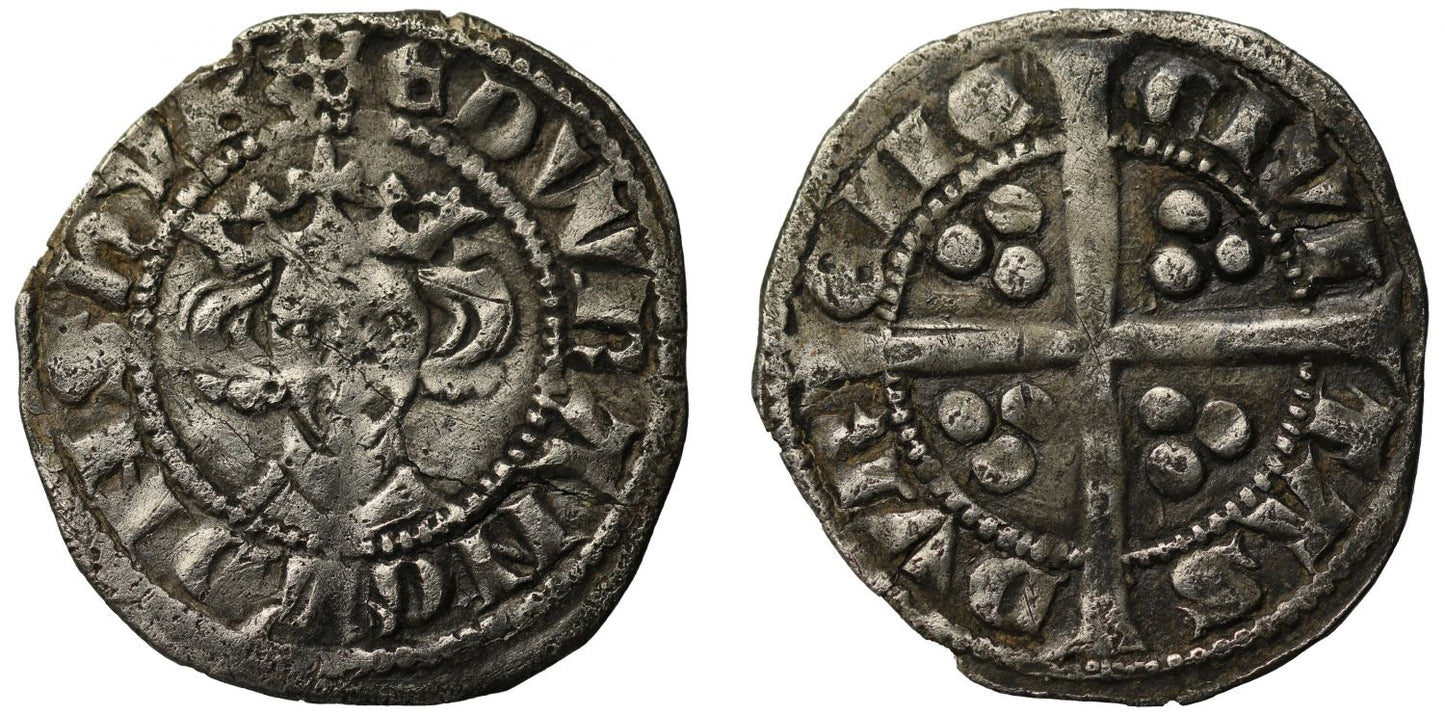FAQs
What makes a coin valuable?
I have coins to sell, what’s the next step?
How will my purchases be shipped?
What happens if I’m not entirely happy with my purchase?
Edward I Penny, type 9b, Durham Mint under Bishop Beck
Edward I (1272-1307), silver long cross Penny, class 9b (1299-1300/1), Durham mint, under Bishop Beck, facing crowned head with star collar, legend and beaded border surrounding, initial mark cross moline, +EDW R AIIGL DIIS hYB, rev. long cross pattee, tri-pellets in inner angles, legend and beaded border surrounding, VILL A DVR HAM, weight 1.22g (SCBI 39:396 North; N.1037/1; S.1423). Toned with some die clash evident, a bold very fine.
The Latin legends translate as "Edward King of England, Lord of Ireland" on the obverse and "City of Durham" on the reverse.
Issued under the ecclesiastical authority of Bishop of Durham Anthony Beck who was also Patriarch of Jerusalem. Anthony Beck born c.1245 and his brothers John and Thomas were from a family of knights from Eresby in Lincolnshire and he was educated at Oxford University from 1267-1270 when he entered the clergy receiving several benefices and attracted attention of the Lord Edward son of Henry III with whom he went on a crusade in 1270. He was Archdeacon of Durham by 1275 as well as Precentor of York and held prebends at Lichfield, London and Wells. Edward appointed Beck keeper of the Wardrobe on 21st September 1274 which he passed to his brother Thomas a month later. Edward named Beck Constable of the Tower of London in 1275 and he was later influential in the Treaty of Aberconwy between Edward and the Prince of Wales. Beck was also sent to Aragon to negotiate the marriage of Edward's daughter to Alfonso of Aragon. Beck was elected Bishop of Durham 9th July 1283, consecrated on 9th January 1284 and enthroned in the cathedral there on Christmas Day of 1285. His service ran as a keen negotiator for the King through the reign of Edward I and into that of his son Edward II, dying at Eltham Palace on 3rd March 1311 an extravagant and wealthy man, with an estate worth 6,000 marks, having built Auckland Castle, Somerton Castle and Durham Castle's Great Hall.
Edward son of Henry III and Eleanor of Proveance was born in June 1239 at the Palace of Westminster and was known as The Lord Edward whilst his Father was King. As a young adult he became involved in the political struggles of the Baronial rebellions and briefly sided with their reform in 1259 and supported the Provisions of Oxford. Edward later reconciled with his Father remaining loyal through the Second Barons War and was held hostage after the Battle of Lewes but later escaped. He went on to defeat Simon de Montfort at the Battel of Evesham in 1265 and within two years the rebellious barons were finished and peace once again reigned. Edward joined the Ninth Crusade to the Holy Land and it was on his way back in 1272 that he received news that Henry III had died on 20th November 1272. Edward Longshanks as he now became known due to his tall stature believed to be 6 foot 2 inches, took a leisurely return to England and was coronated on the 19th August 1274 at Westminster Abbey. It was not long till he had to suppress a rebellion in Wales in 1276-77 and again in 1282-83 which culminated in a full conquest with a series of castles built and English rule firmly in place. Edward continued to reform administration and common law with feudal liberties and then set his sights on Scotland claiming feudal suzerainty leading to war which continued after Edward's death though he was almost victorious on several occasions and became known as The Hammer of the Scots. Edward also became involved in war with France as a Scotch ally against Philip IV who confiscated the Duchy of Gascony, though Edward did recover it. The cost of these actions was heavy taxation for all and when he died in 1307 his son Edward II inherited conflict and strife.
Edward I was married twice, first in 1254 to Eleanor of Castile who bore him fourteen children and possibly two more as a number did not live to adulthood and only the one son Edward outlived his Father to become the next King. Eleanor died aged around 48 on 28th November 1290 and is buried in Westminster Abbey. Edward went on to marry Margaret of France in 1299 who bore him two sons and a daughter and was some 40 years his junior. Edward died whilst campaigning in the north on the morning of 7th July 1307 at Burgh by Sands in Cumberland suffering from dysentery, and he was buried at Westminster Abbey on 27th October of that year.
Durham is situated on the River Wear and the Norman cathedral was built between the years of 1093 and 1133. King Stephen advanced to Durham against King David of Scotland in 1135 and peace was signed there in 1139. The castle was later seized by Henry of Northumbria and William Cumin in 1141. Minting activity occurs there from the reign of William I to Henry III though there is hardly any documentary evidence in the 13th Century. The Bishops of Durham continued to operate the silver mines of the area but the only dialogues on the subject date from the 1140s up to 1195. For further reading consult "The Metal in Britain's Coins" by Dr Graham Birch.
Provenance:
Ex Collection of an English Doctor part III, Sovereign Rarities fixed price list online August 2022.
FAQs
What makes a coin valuable?
I have coins to sell, what’s the next step?
How will my purchases be shipped?
What happens if I’m not entirely happy with my purchase?













